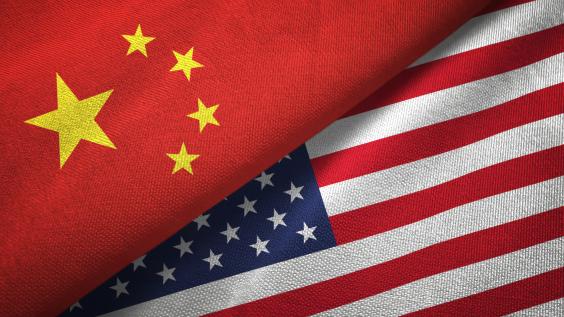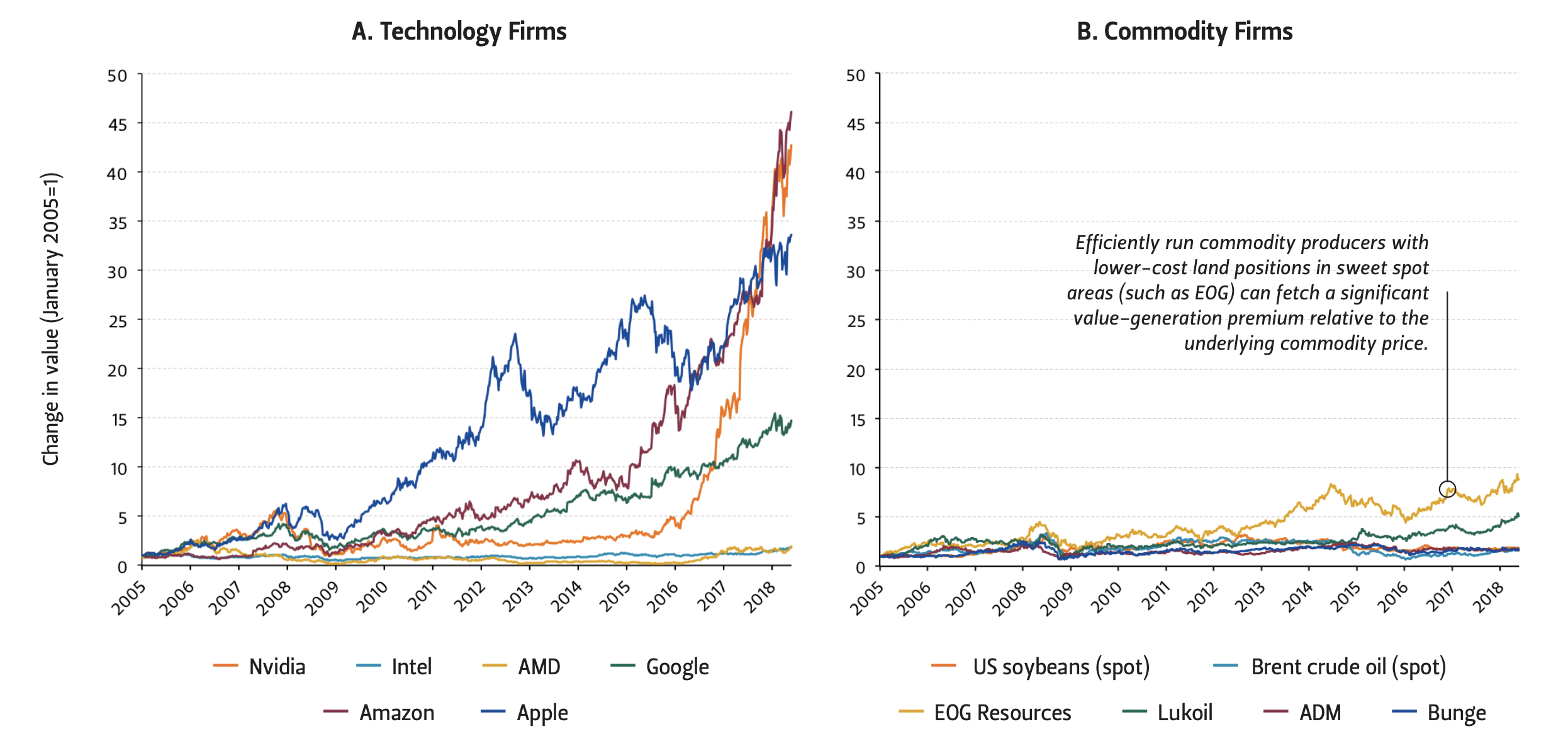Brains vs. Grains: US Technological Leadership Faces a Stiff Challenge as Competition With China Heats Up

Table of Contents
Author(s)
Share this Publication
- Download PDF
- Print This Publication
- Cite This Publication Copy Citation
Collins, Gabriel. 2018. Brains vs. Grains: US Technological Leadership Faces a Stiff Challenge as Competition With China Heats Up. Issue brief no. 06.25.18. Rice University’s Baker Institute for Public Policy, Houston, Texas.
The intense US focus on trade deficit reductions during recent negotiations with China brings to mind a vivid and appropriate Chinese idiom: “grasping the sesame seeds while dropping the watermelon” (捡了芝麻丢了西瓜). A core US position to date—expressed after meetings in May 2018 between the Trump administration and a Chinese delegation led by Liu He, the special envoy of China’s President Xi Jinping—emphasizes “meaningful increases in United States agriculture and energy exports” to China.1 There is an increasing risk that as the trade conflict ramps up, the administration will back down from its tough recent rhetoric and instead settle for a mercantilistic deal under which China agrees to imports more US goods and services. Such an outcome would prioritize small, near-term domestic political gains while failing to appropriately position US policy for a technology race that will determine global influence for decades to come.
Natural resource businesses centered on the production and sale of fungible commodities such as corn and oil are fundamentally cost-based. The party who can produce the most volume at the lowest price gets the best and biggest corner of the sandbox. The corollary, however, is there is still a lot of sandbox left for participants higher up the cost curve to vie for market share.
Think of Saudi Arabia’s role in the oil market versus that of the Russians, US shale drillers, Canadians, and more than two dozen other producers and you’ll start to get the picture. Saudi Aramco can supply up to 12 million barrels of oil per day (bpd) into a market requiring slightly less than 100 million bpd. This is a big share by any measure, but one that leaves approximately 85 million more bpd of required volume that other producers can compete to supply.
Technology is a much more “winner take all” world, highlighting the differences between cost advantage—which is crucial in commodity markets—and technological dominance. The country (or company) that establishes technological dominance does not just get the prime corner of the sandbox. It also determines the box’s shape, the type of sand and, at a basic level, the terms that others must meet if they wish to enter the box and play.
A strong technology and innovation system is the economic equivalent of a nuclear “breeder reactor” that consistently generates more fuel than it consumes. Figure 1 gives a sense of how tech firms can generate incredible economic value. The wealth produced by tech leaders (measured by the market capitalization of publicly traded equities) has outstripped that of top natural resource firms by as much as five-fold over the past dozen years. The commodity firms shown are Archer Daniels Midland and Bunge—major grain traders and processors whose returns over time closely track the prices for soybeans—and EOG Resources and Lukoil, which have been able to deliver meaningful return premiums over the price of the crude oil that underpins their business.
Figure 1 — Change in Value of Selected Technology and Commodity Firms

Sources Bloomberg, author’s analysis.
Commodity firms generally control what is basically a fixed stock of assets that can be converted into value in various ways based on commodity prices, the capabilities of the firm’s management team, and some other internal and external factors. In contrast, intellectual property-focused firms have a dynamic asset stock, since imaginative human beings can “create” net additional assets through inventiveness and innovation. IP-oriented firms are also different than real property firms in the sense that if they fail to create products demanded by the market, they crash and burn, often leaving little of value behind. In contrast, a natural resource firm that cannot compete on cost at a given commodity price level frequently still retains substantial underlying value after changing management teams and/or passing through the bankruptcy process and shedding debt and other financial burdens.
And as discussed above, the market-shaping potential of some of these innovations can confer substantial operational leverage that magnifies returns. There is also a self-reinforcing dynamic in that the success of service-oriented tech firms such as Google begets demand for underlying technology “backbone” components like servers, microchips, and so forth.
The market capitalization of publicly traded firms is admittedly a crude directional indicator that fails to capture non-listed enterprises or second- and third-order gains. Systematically accounting for these factors would very likely increase the gap between “brains and grains” even further. To put the numbers in perspective, the USDA estimated total farm cash receipts in the US to be approximately $360 billion in 2017, while net farm income was about $60 billion—implying a gross margin of roughly 17%.2 Meanwhile, the 10 largest US tech firms generated more than 2.5 times the gross revenues of the entire farm sector in 2017, and could enjoy additional aggregate revenue growth of nearly 16% in 2018, which would bring them to nearly three times the revenue of the US farm sector.3
Technology and a strong national basic materials production capacity are not mutually exclusive—to the contrary, they reinforce each other at many levels in the United States when it comes to generating comprehensive national power. Indeed, new technologies developed in Silicon Valley, the Route 128 Corridor, Austin, Denver, and other hubs are playing a vital role in the present US hydrocarbon and agricultural booms that allow large-scale commodity exports in the first place.
Natural resource plays generally derive value from a combination of long-term demographic trends that drive demand, above-ground factors in certain areas that constrain supplies and drive investment to more politically favorable regions, and advantaged geographical positions that favor first-mover producers. In short, what most directly determines a commodity producing country’s competitive position is “what it has” (i.e., natural and positional capital endowment) much more than “what it does” (i.e., human capital and its ability to generate high-return intellectual property).
Bulk commodity exports are not a core source of US national power and influence. Abundant US grain, oil, and natural gas supplies generate the greatest all-in value by promoting domestic industrial and manufacturing activity, acting as a natural hedge when commodity prices rise globally and, in the case of oil and gas, by creating space for US policymakers to place our national interests ahead of the parochial interests of specific major resource-exporting countries. The liberation of policymakers’ thought process is unique to the United States, whose government is the only one among the five largest oil and gas producing nations that does not hold an ownership stake in the resource itself.
Furthermore, such goods are fungible and can be procured from a wide range of alternative sources. If China decided tomorrow to stop importing US light-sweet crude oil (or slap tariffs on it), it could source similar grades from Angola, Nigeria, Southeast Asia, and multiple other sources without materially affecting the quality of the refined products going into cars in Beijing, trucks in Shanghai, and chemical plants near Ningbo. Chinese consumers would likely pay higher costs and US producers would realize somewhat lower netbacks for their oil, but the commodity itself is nonetheless highly substitutable.
Likewise, a Chinese farmer feeding soybean meal to his pigs or chickens will not care whether beans originate from the US, Brazil, Argentina, Uruguay, and so forth. These are all fungible goods that at a molecular level are basically indistinguishable from one another. The commodities’ undifferentiated nature makes them interchangeable, which means that (1) suppliers are highly replaceable, (2) the sellers’ ability to reap long-term premium returns is dictated largely by their cost of production, and (3) sellers are generally price takers, with little power to shape market conditions.
In contrast, exports of high-technology goods are a foundational source of US global economic influence. If Chinese buyers lost access to high-end US microchips tomorrow, they could likely find replacement chips, but the products would be far less capable. It would be as if a high-end sports car had its turbocharger removed. With a bit of re-tuning, the car could still drive, but it would not have nearly the level of performance it was originally designed for, much less be competitive in a tough global marketplace. For these reasons, a range of Chinese entities are aggressively working to make their country’s tech sector less dependent on American-made semiconductors. The pursuit of semiconductor sovereignty is exemplified by Alibaba chairman Jack Ma’s recent remark that “100 percent of the market for chips is controlled by Americans … And suddenly if they stop selling—what that means, you understand. And that’s why China, Japan, and any country, you need core technologies.”4
Achieving technological pre-eminence depends on a range of social, cultural, and political factors. But is not contingent on having a massive domestic natural resource bounty. Indeed, such an abundance of “easy cash flow generators” such as oil and gas can actually undermine a nation’s technological competitiveness. In many cases it encourages rent-seeking, crowds out the private sector, and saps the incentives for would-be entrepreneurs to take risks on new businesses.
In today’s world, it is a nation’s reservoir of intellectual resources, a societal capacity to foster innovation, and the cultural and institutional ability to translate technical breakthroughs into economic value creation that are the key competitive differentiation factors. These advantages are accentuated when a country is a global talent magnet open to immigration, and the individuals in this talent pool maintain and develop international networks.5 The US has historically cultivated these advantages, but must continually invest in renewing and updating them, lest our “operating system” become outdated and uncompetitive.
In addition to fostering a cutting edge domestic innovation ecosystem, the US must also protect the rootstock from which its trees of economic productivity grow. Chinese firms and the PRC government cannot steal US grain farms or oilfields, but they can—and do—pilfer the cutting-edge ideas of US firms as well as some of their employees. They have huge incentives to do so. Initially, the forced and illicit transfer of valuable intellectual property is a way to close the gap between domestic Chinese industries and US counterparts who, in technological terms, can be more than a generation ahead.
Yet as China’s well-funded tech sector continues to rapidly grow in scale and capability, the risk shifts from a simple closing of the gap between Chinese and US firms, to the potential for outright overtaking in key areas such as artificial intelligence and biotechnology. Market leadership in such areas could make Chinese firms the new global market leaders and allow them to capture economic rents, and the benefits of being the global technological trendsetter, that would otherwise accrue to the United States. The challenges posed by China’s “One Belt, One Road” and most other geopolitical initiatives are sideshows compared to the core challenge of China’s rising domestic innovation-industrial complex.6
Globally-competitive tech enterprises can potentially take root anywhere there is an appropriate supply of top-tier intellect (not necessarily native-born), and a political system willing to support scientific research and construct world-class research institutions.7 As such, figuring out how to balance openness to the global flows of people, ideas, and money that underpin US technical and economic dynamism with the reality that Chinese government interests will try and leverage this openness to purloin technological edges will be a key strategic challenge for many years.
The Challenge to Washington
Thus far, the Trump administration’s policies have largely failed to position US interests for success in this escalating US-China technology competition. It acknowledges in the National Security Strategy that the countries are strategic competitors.8 But this largely symbolic move is overshadowed by internal discord. Certain senior officials seek to position the US for a marathon economic and strategic competition with China, while others—perhaps including the president himself—appear inclined to stake out aggressive initial positions and then allow themselves to be seduced by today’s promises of more trade and a “deficit reduction,” to the detriment of the longer-term US competitive position. At the same time, the White House indiscriminately swings a blunt hammer in self-injurious ways—for example, by imposing tougher visa requirements on Chinese students studying in the US, while focusing diplomatic efforts on issues that resonate with certain domestic constituencies, but do not fundamentally advance US national interests, particularly in the technology space.
The “Made in China 2025” policy clearly reflects one of Beijing’s core objectives: displacing the US as the global technological superpower.9 US policymakers urgently need to recognize this reality. And it is not a simple “claim victory now and move on” type of issue, which is worrisome given the administration’s clear affinity for such a course of action. “Reality” in the context of a tech race also means that goods, money, and knowledge should—with proper safeguards—continue flowing back and forth across the Pacific. The benefits of exchange remain significant, despite the fact that each country is preparing for conflict with the other.
We must strive to maintain US technological leadership while recognizing that as China’s tech sector, universities, and government labs continue to develop, they will contribute significantly to the expansion of global intellectual capital. Cures for diseases, advanced computer hardware, solutions to the carbon conundrum, and other technology-derived goods are increasingly as likely to come from labs in China as they are from research facilities in the US, Netherlands, and other countries with top-tier scientific complexes.
Focusing on trade deficits, boosting tariffs, and restricting immigration are precisely the wrong ways to address the strategic dilemmas raised by the intensifying US-China technology race. The evolving competition is complex, and will require an integrated and thoughtful effort on the part of government policymakers and US commercial entities and universities. Moreover, it will likely last for decades. Grains and commodities are vitally important to the foundation of our comprehensive national power, but brain power will drive economic growth forward. China’s leaders recognize this reality, are looking past the “sesame seeds” of the trade deficit, and have firmly grasped the “watermelon” by focusing on accelerating development of high-tech industries. The question is, how soon will Washington catch up?
Endnotes
1. “Joint Statement of the United States and China Regarding Trade Consultations,” May 19, 2018, https://www.whitehouse.gov/briefings-statements/joint-statement-united-states-china-regarding-trade-consultations/ (accessed June 20, 2018).
2. “2018 Farm Sector Income Forecast,” USDA Economic Research Service, https://www.ers.usda.gov/topics/farm-economy/farm-sector-income-finances/farm-sector-income-forecast/ (accessed June 8, 2018).
3. John Shinal, “The ten biggest US tech companies will top $1 trillion in sales this year,” CNBC, January 21, 2018, https://www.cnbc.com/2018/01/21/ten-largest-us-tech-firms-2018-revenue-seen-topping-1-trillion.html.
4. Yuji Nakamura and Yuki Furukawa, “Jack Ma Says Nations Need Tech to Sidestep US Grip,” Bloomberg, April 25, 2018, https://www.bloomberg.com/news/articles/2018-04-25/jack-ma-says-nations-need-own-tech-to-sidestep-u-s-control.
5. See, for instance, “Global Startup Ecosystem Report 2018,” Startup Genome, https://startupgenome.com/all-report-thank-you/?file=2018.
6. Alexandra Ma, “Inside ‘Belt and Road,’ China's mega-project that is linking 70 countries across Asia, Europe, and Africa,” Business Insider, January 31, 2018, http://www.businessinsider.com/what-is-belt-and-road-china-infrastructure-project-2018-1.
7. For a list of highly innovation-centric economies, see Soumitra Dutta, Bruno Lanvin, and Sacha Wunsch-Vincent, “The Global Innovation Index 2016,” http://www.wipo.int/edocs/pubdocs/en/wipo_pub_gii_2016.pdf.
8. “National Security Strategy of the United States of America,” December 2017, https://www.whitehouse.gov/wp-content/uploads/2017/12/NSS-Final-12-18-2017-0905.pdf.
9. “Made in China 2025” is an official PRC government policy program released in 2015 that, in the words of an in-depth report by the Mercator Institute for China Studies, “aims for substitution: China seeks to gradually replace foreign with Chinese technology at home—and to prepare the ground for Chinese technology companies entering international markets.” A range of high value-added, high-technology sectors worldwide are likely to be affected, particularly in South Korea, Japan, the EU zone, and the US. Jost Wübbeke, Mirjam Meissner, Max J. Zenglein, Jaqueline Ives, Björn Conrad, “Made in China 2025: The making of a high-tech superpower and consequences for industrial countries,” December 2016, https://www.merics.org/sites/default/files/2017-09/MPOC_No.2_MadeinChina2025.pdf.
This material may be quoted or reproduced without prior permission, provided appropriate credit is given to the author and Rice University’s Baker Institute for Public Policy. The views expressed herein are those of the individual author(s), and do not necessarily represent the views of Rice University’s Baker Institute for Public Policy.



